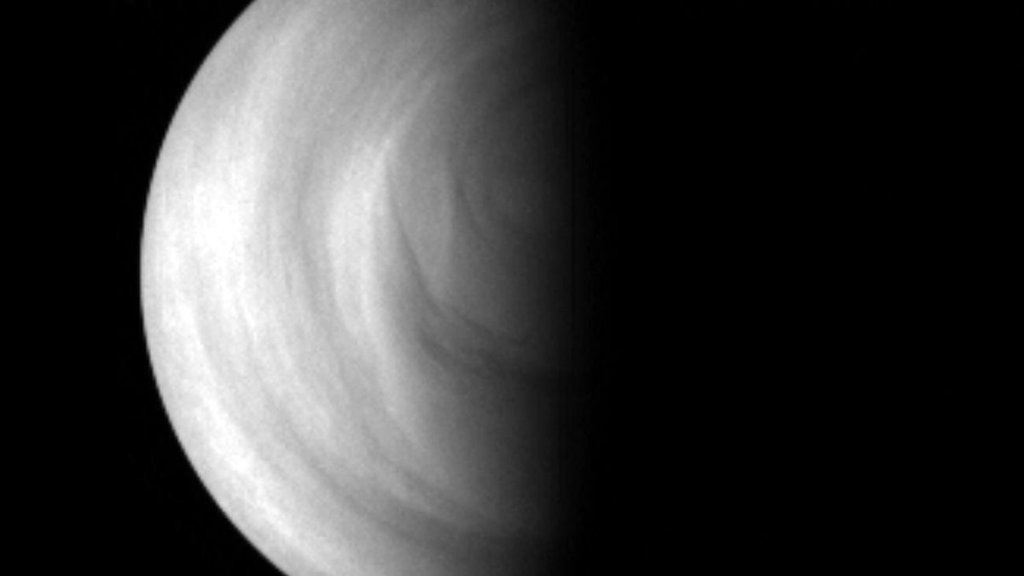
Between Venus’ atmospheric currents, a layer of reactive oxygen (Image Credit: Space.com)
Today, our sister planet Venus resembles an environment as close to hell as one can imagine. Surface temperatures on the amber world soar to 450 degrees Celsius (842 degrees Fahrenheit), while about 96% of the planet’s crushing atmosphere is made up of carbon dioxide. Once upon a time, however, Venus may have resembled something much closer to our balmy home — Earth.
That was until runaway greenhouse gas processes, likely triggered by volcanic activity, sent Venus on a trajectory that resulted in the noxious neighbor we see today. However, in new research that furthers our understanding of the planet’s atmospheric evolution, astronomers announced they’ve directly detected the presence of atomic oxygen in both the day and night side of the Venusian atmosphere.
Atomic oxygen is the highly reactive chemical cousin of molecular oxygen (the stuff we breathe and simply refer to as oxygen.) Unlike molecular oxygen, or O2, made of oxygen atom pairs, atomic oxygen is composed of individual oxygen atoms.
Related: The deadly atmosphere on Venus could help us find habitable worlds. Here’s how
At risk of simplification, those individual oxygen atoms are therefore always ready to pair with another atom or molecule. That’s what makes atomic oxygen so reactive — pairing up would make a single oxygen atom more stable, so these oxygen singlets want to react. This is also why molecular oxygen isn’t as reactive. Its oxygen atoms are all buddied up.
Detecting atomic oxygen
The team of astronomers led by Heinz-Wilhelm Hübers, director of the German Aerospace Center, used the Stratospheric Observatory for Infrared Astronomy (SOFIA) — an airborne observatory, to collect data on Venus’ atmosphere.
“We were able to plan a flight route which allowed us to observe Venus (which is at low elevation) shortly before sunset for three days, each day for about 20 minutes,” Hübers told Space.com.
Onboard SOFIA was the upGREAT Terahertz heterodyne spectrometer, which was used for the observations. Hübers explained that this particular spectrometer is especially sensitive to the frequency and wavelength of atomic oxygen, which are 4.74 terahertz and 63.2 microns, respectively.
The atmosphere on Venus houses two strong currents. The lower of the two sits below 70 kilometers (43.5 miles) in altitude, where the equivalent of hurricane-force winds on Earth blow against the direction of Venus’ rotation. The higher current sits above 120 kilometers (74.6 miles) in altitude with winds that flow in the direction of the planet’s rotation.
“A layer of atomic oxygen exists between these two opposing atmospheric currents,” Hübers says.
This layer of atomic oxygen, the scientists believe, is produced by ultraviolet radiation coming from the sun, which breaks down carbon dioxide and carbon monoxide in Venus’ atmosphere into atomic oxygen and other molecules. In this process, known as photolysis, high-energy photons collide with carbon molecules to force the molecules to essentially rip apart.
Because the atomic oxygen is predominantly concentrated around 100 kilometers (62 miles) in altitude between the two circulation patterns, it’s possible these currents play a role in distributing the substance around the planet. However, Hübers says the team couldn’t quite quantify this yet with their current measurements.
Although, he does mention they observed a local enhancement of atomic oxygen on the planet’s nightside, close to the line which separates day and night, known as the “terminator.” Possibly, this enhancement could be caused by the terminator’s winds.
Should future missions to Venus be worried?
While atomic oxygen was detected in Venus’ atmosphere, it’s worth noting that the concentration was much lower than what we find in Earth’s atmosphere. Earth’s atmosphere has roughly 10 times more atomic oxygen than Venus’ does. In fact, the relatively high concentration of atomic oxygen in the atmosphere around our planet is considered a threat — these particles are responsible for some corrosion of satellites in Low Earth Orbit (LEO), including the International Space Station.
The presence of the highly reactive oxygen on Venus, therefore, shouldn’t pose too much of a corrosive threat to any future satellites that get sent there.
“Besides that, it is very interesting to measure the altitude distribution of the atomic oxygen in the Venusian atmosphere in order to understand the chemistry and physics of the atmosphere better and to compare it with Earth,” says Hübers.
Atomic oxygen, day and night
It was important for researchers to collect data from both the day and night side of Venus, largely because the planet rotates at an excruciatingly slow pace — one day on Venus lasts 243 Earth days, or 5,832 hours.
According to Hübers, the most likely explanation for this slow rotation is that the gravity of the sun induced tides on Venus during an early stage of the planet’s lifecycle, when it was more or less a liquid, molten body. The rotational energy of Venus possibly worked against the formation of tides on the world due to that molten structure, and eventually, scientists think it slowed to its current-day rotational speed.
Ultimately, the results from the study paint a picture of the Venusian atmosphere as starkly different to our own, and highlight how small differences in our past can accumulate over time to result in dramatically different futures.
The study was published Tuesday (Nov. 7) in the journal Nature Communications.





